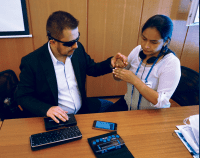Evidence-based interventions are key for successful outcomes.
Editor’s note: This is a web exclusive article for the October 2021 issue of American Nurse Journal.
Obesity is a complicated chronic disease with many contributing and interrelated factors that include genetics, biology, metabolism, and neurobehavior. It’s also affected by society, the economy, and culture. (See Obesity facts and figures.)
Obesity facts and figures
Obesity profoundly impacts morbidity, mortality, and healthcare costs.
- More than one-third (36.5%) of U.S. adults are affected by obesity.
- Related healthcare costs range from $147 billion to $210 billion annually (21% of total national healthcare spending).
- Weight loss of just 3% to 5% can produce clinically significant health improvements.
- Only an estimated 1% of the clinically eligible population receives surgical treatment for obesity.
Health-related consequences of excess body weight—heart disease, stroke, type 2 diabetes, and some cancers—comprise some of the leading causes of preventable death. Obesity should be treated, similar to other chronic diseases, with expert complex care guided by evidenced-based practice guidelines. Current recommendations include screening all adults for obesity and offering or making referrals for intensive, multicomponent behavioral interventions to patients with a body mass index (BMI) ≥30 kg/m2. However, despite these recommendations and medical and surgical advances, obesity prevalence continues to rise. Evidence-based interventions rarely are used.
Nurses and nurse practitioners have a unique opportunity to recognize patients at risk and skillfully intervene to improve the quality of care provided to those affected by obesity. But first, we have to change the way we think about, talk about, and approach obesity treatment.
Assessment
The stigma associated with obesity may cause individuals to avoid routine medical care. A study by Fruh and colleagues shows that healthcare providers spend less time with patients who are affected by overweight or obesity. Nurses can help ensure patients receive age-appropriate screening and access to other preventive medical care.
Overweight and obesity frequently are defined by BMI, but that’s just one piece of the puzzle. An elevated BMI (>25) should trigger a full assessment, including a thorough weight history that explores rate of weight gain (lifelong vs. sudden onset), aggravating factors (such as eating patterns, physical activity level, and access to healthy food options), past weight-loss attempts, and family history. Also assess for signs or history of obesity-associated disorders, medications that may affect weight, and indicators of potential eating disorders. Don’t overlook family history, support systems, and socioeconomic status. (See Medication-induced obesity.)
Medication-induced obesity
Many medications can lead to weight gain and loss.
Medications that may lead to weight gain
- Amitriptyline
- Antihistamines
- Beta blockers
- Clozapine
- Doxepin
- Gabapentin
- Glucocorticoids
- Imipramine
- Lithium
- Meglitinides
- Most insulins
- Olanzapine
- Paroxetine
- Sulfonylureas
- Thiazolidinediones
- Valproate
- Zotepine
Medications that may lead to weight loss
- Alpha glucosidase inhibitors
- Bupropion
- GLP-1 agonists
- Lamotrigine
- Metformin
- Sodium glucoses co-transporter 2 inhibitors
- Topiramate
- Zonisamide
Consider a 24-hour food recall to determine problem areas, and ask the patient where food is purchased and who buys and prepares it. Food deserts (communities with limited access to grocery stores and healthy food options), financial insecurity, cultural background, abuse, and lack of transportation can all affect dietary decisions.
Ask about timing and frequency of meals, where food typically is eaten, and what triggers eating (for example, hunger, cravings, anxiety, boredom, or reward). Patterns such as emotional eating, skipping meals, or nighttime eating could indicate maladaptive eating disorders. Also ask about excessively overeating, purging, and other behaviors consistent with eating disorders.
Your assessment also should include questions about current physical activity, including frequency, intensity, duration, type, and level of enjoyment. Mobility, equipment needs, access to locations amenable to exercise, and health risks should be discussed. Obesity-specific biomechanical risks include stress on weight bearing joints, immobility, and problems related to tissue compression. Signs and symptoms of compression disorders include obstructive sleep apnea, skin friction, gastroesophageal reflux, and high blood pressure. Assess for metabolic disorders, such as dyslipidemia or type 2 diabetes. Your findings may warrant additional evaluation. (See Diagnosing obesity-related conditions.)
Diagnosing obesity-related conditions
Your assessment should include screenings for any suspected obesity-related conditions.
| Suspected condition | Screening |
| · Anxiety
· Depression · Eating disorders |
· Referral for psychological testing
· Screening questionnaires |
| · Dyslipidemia | · Lipid panel |
| · Female infertility or PCOS
· Male hypogonadism |
· Androgen levels
· Estradiol · Imaging · LH/FSH · Prolactin · Total and free testosterone |
| · Hormonal disorders | · TSH and free T4 for suspected hypothyroidism
· Cortisol evaluation for hypercortisolemia/Cushing’s syndrome with dexamethasone suppression test |
| · Hypertension | · BP |
| · Metabolic syndrome | · BP
· Fasting glucose · HDL · Triglycerides · Waist circumference |
| · Nonalcoholic fatty liver disease | · Liver function lab tests
· Follow-up liver ultrasound if labs elevated |
| · Obstructive sleep apnea | · Polysomnography |
| · Osteoarthritis | · Imaging to confirm physical exam |
| · Prediabetes
· Type 2 diabetes |
· 2-hour oral glucose tolerance test
· A1C · Fasting or random glucose |
BP = blood pressure, HDL = high-density lipoprotein, LH/FSH = luteinizing and follicle-stimulating hormones, PCOS = polycystic ovary syndrome, TSH = thyroid-stimulating hormone
Diagnosis
BMI cutoffs frequently are used for coding as it relates to weight.
- Overweight: BMI 25–29
- Obese: BMI 30–35
- Morbidly obese: BMI 35–39 with a weight-related co-morbidity or BMI >40
However, BMI is just one point of interest. Those with extremes in muscle mass or stature may be inappropriately labeled overweight or obese. Those with a “normal” BMI may have central or abdominal obesity (waist measurement >35 inches for women, >40 inches for men).
Correctly diagnosing the underlying causes or contributors of obesity is critical to accurately treating it. Many genetic conditions—such as Prader-Willi syndrome, Bardet–Biedl syndrome, Turner syndrome, Trisomy 21 (Down syndrome), and Fragile X syndrome—will likely be previously diagnosed in adult patients. However, if you suspect other contributing factors, such as hypothalamic damage, insulinomas, untreated hypothyroidism, hypercortisolism (Cushing’s disease), or sleep disorders, advocate for tests to confirm or rule them out. Immobility, depression, anxiety, binge eating disorder, and other problems discovered during the assessment should be added as a new diagnosis and included in the treatment plan.
Outcomes and planning
Goal setting and planning during treatment should be a shared medical decision. The ultimate goal should be to improve health and quality of life. Weight loss can reduce, mitigate, or reverse the effects of health-related consequences of excess weight, which may reduce the need for medications and help patients save money on copays and office visits.
Weight loss
Setting attainable goals is a key step in planning. The patient may have 100 pounds to lose, but telling them to lose 100 pounds will set them up for failure. A more reasonable goal would be to lose 5% to 10% of their current body weight. For a 250-pound woman, that would be an initial weight loss goal of 12.5 to 25 pounds. Not only is this more attainable, but a 3% to 5% weight loss is associated with improvements in other chronic conditions such as diabetes and hypertension. Other realistic weight loss goals could be 1 to 2 pounds per week or 5 to 10 pounds per month.
Dietary planning
Planning for dietary changes can be complicated. Food is part of the culture and social interaction of all nations, races, and ethnicities. Every population has their own set of social norms related to food, which will have to be navigated. Consider referring the patient to a dietitian. If a dietitian isn’t available or the patient’s insurance doesn’t cover this service, choosemyplate.gov offers dietary basics.
No single diet or dietary pattern is recommended over another. Meal replacements, Mediterranean diets, low-fat, high-protein, and all others have pros and cons. All weight loss diets work by creating a calorie deficit. What a person eats is as important as how much, but it may be less frustrating to address quantity first. Tracking intake on an app can provide instant feedback on meeting calorie goals. Most available apps (MyFitnessPal, Lose It!) will set appropriate goals based on users’ height, weight, and activity level. In general, if the patient’s goal is to lose 1 to 2 pounds per week, then a calorie deficit of 500 to 1,000 calories per day will, in theory, be appropriate. Calorie goals of 1,200 to 1,500 calories per day for women and 1,500 to 1,800 calories per day for men usually are acceptable to allow for weight loss while still providing adequate nutrition.
Your guidance can help patients navigate dietary changes. Teach them how to read food labels, with particular attention to portion sizes. For example, food packaging can be misleading with multiple servings contained in one small package. Many people aren’t aware that liquid calories count and don’t include them in their overall intake. However, many beverages—including whole milk, fruit juice, sweet tea, soda, and other sugar sweetened beverages—contain high calories. Patients may benefit from avoiding these beverages.
Lifestyle changes related to eating patterns also are useful talking points. Meal planning and having low-calorie healthy snacks available can make the difference between a stress-free day and a derailed diet. Encourage mindful eating, and advise patients to avoid eating while distracted in front of the TV or computer. (See 5 things patients should do to promote healthy eating.)
5 things patients should know to promote healthy eating
- Read food labels, especially serving sizes.
- Eliminate sugar-sweetened beverages.
- Plan meals and snacks.
- Use an app (MyFitnessPal, Lose It!) to aid calorie counting.
- The goal is never 100% perfection. Strive for eating well 90% of the time.
Physical activity
Increasing physical activity and exercise is essential to weight loss and weight maintenance, but recommendations must be based on a patient’s ability to make this change. Walking is a great way to incorporate low-impact exercise into a weekly routine, but if a patient can’t ambulate easily or lives in an unsafe neighborhood, this isn’t a useful recommendation. Also, potential health risks should be assessed. For example, Patients with diabetes may be at risk for hypoglycemia with exercise.
Any activity is better than none and should be encouraged. Eventual exercise goals should be at least 150 minutes of moderate-intensity exercise split into at least 3 sessions throughout the week. Two additional sessions, of resistance training, each at least 20 minutes, also are recommended. Remind patients that they can find other ways to incorporate activity into their daily routines. For example, they can park further from building entrances (if safety isn’t compromised) and take the stairs instead of the elevator.
Step trackers can be a fun way to challenge friends or family to increase activity. If 1 calorie is burned for every 20 steps, then 500 calories could be burned per 10,000 steps.
Medication changes
Talk with patients about the risks and benefits of medications associated with weight gain. Weight neutral or beneficial alternatives should be considered for patients taking medications associated with weight gain. Whenever clinically appropriate, maximizing weight beneficial medications, such as incretin therapy in Type 2 diabetes, should be considered.
Anti-obesity medications should be considered for patients with a BMI ≥27 who have a weight- related comorbidity and those with a BMI ≥30 regardless of other chronic conditions. Current recommendations support prescribing medications with Food and Drug Administration–approved weight-loss indications in conjunction with diet and exercise. Just as you wouldn’t withhold antihypertensives in patients with uncontrolled hypertension in favor of a low-sodium diet first, the same can be said for obesity management. (See Anti-obesity medications.)
Anti-obesity medication
The Food and Drug Administration has approved several anti-obesity medications. All of these medications are contraindicated in pregnancy. Brand names listed are the ones approved for use of the drug in patients with obesity.
| Medication | Action | Side effects and cautions | Considerations |
| Liraglutide (Saxenda)
18 mg/3 mL multidose pen, subcutaneous injections once daily, increased as follows (unless not tolerated): Week 1: 0.6 mg Week 2: 1.2 mg Week 3: 1.8 mg Week 4: 2.4 mg Week 5: 3.0 mg
Semaglutide (Wegovy) Single-use auto-injector subcutaneous injections, once weekly, increased as follows (unless not tolerated): Month 1: 0.25 mg once a week for 4 weeks Month 2: 0.5 mg once a week for 4 weeks Month 3: 1 mg once a week for 4 weeks Month 4: 1.7 mg once a week for 4 weeks Month 5 and beyond for maintenance: 2.4 mg once a week
|
· GLP-1 receptor agonist slows gastric emptying and increases satiety after eating. | Black box warning:
· Thyroid C-cell tumor risk
Contraindications: · Multiple endocrine neoplasia syndrome type 2 · Personal or family history of medullary thyroid carcinoma
Adverse effects: · Constipation · Nausea · Delayed gastric emptying |
· Avoid in patients with pancreatitis.
· In patients with diabetes, reduce insulin or sulfonylurea dose. · Education about potential GI side effects and dietary changes (smaller meals, avoiding triggering foods) before starting medication may ameliorate side effects. |
| Naltrexone ER/bupropion ER (Contrave)
8 mg naltrexone/90 mg bupropion · Week 1: 1 tablet daily in the morning · Week 2: 1 tablet morning and evening · Week 3: 2 tablets in the morning and 1 tablet in the evening · Week 4: 2 tablets morning and evening
Do not crush, chew, or take with high-fat meals. |
· Thought to work on the hypothalamus (appetite regulatory system) and mesolimbic dopamine circuit (reward system). | Black box warning:
· Monitor closely for worsening and emerging suicidal thoughts and behaviors.
Contraindications: · Chronic opioid use · Concurrent use of other bupropion-containing products · Eating disorder · Seizure disorder · Uncontrolled hypertension
Adverse effects: · Constipation · Headache · Hepatotoxicity (naltrexone) · Increased risk of manic, mixed, or hypomanic episodes in patients with bipolar disorder · Insomnia · Nausea · Transient increase in BP or HR · Vomiting |
· Can cause false positive urine test results for amphetamines.
· Good choice for those who smoke, those with depression, those who eat emotionally, and those with cravings. |
| Orlistat
· 120 mg three times daily with fat-containing meals (Xenical) OR · 60 mg (Alli sold over the counter) |
· Pancreatic lipase inhibitor | Contraindications:
· Cholestasis · Chronic malabsorption syndrome Adverse effects: · Cramps · Fecal incontinence · Flatulence · Oily spotting · Reduced absorption of fat-soluble vitamins
Rare adverse effects: · Oxalate kidney injury · Severe liver injury |
· Few interactions but can decrease absorption of some medications.
· May help with chronic constipation or high LDL levels. |
| Phentermine
· 15 mg, 30 mg, or 37.5 mg/day in 1 to 2 divided doses OR · 8 mg 30 minutes before meals three times a day (Lomaira) |
· Central nervous system stimulant acting as an anorexiant | Contraindications:
· Agitated state · Cardiovascular disease · Drug use disorder · Glaucoma · Hyperthyroidism · SSRIs
Adverse effects: · Constipation · Dry mouth · Increased heart rate and blood pressure · Insomnia · Nervousness |
· Abuse potential
· Does not help with emotional or behavioral eating. · Inexpensive · Short-term use (<12 weeks) by FDA label but some guidelines support long-term use (Apovian et al) |
| Phentermine/topiramate ER (Qsymia)
· Initial dose: 3.75 mg phentermine/23 mg topiramate once daily in the morning for 14 days · Titrate: 7.5 mg/46 mg daily for 12 weeks; 11.25 mg/69 mg daily for 14 days; 15 mg/92mg once daily (max dose) · Taper dose to stop. |
· Anorexiant potentiated by topiramate | Contraindications:
· Glaucoma · Hyperthyroidism · Kidney stones · MAOI · Topiramate is teratogenic. · Topiramate may enhance potential toxic effect of metformin.
Adverse effects: · Anxiety · Cognitive disturbances · Constipation · Depression · Dry mouth · Elevated heart rate · Insomnia · Paresthesia · Taste disturbance |
· May be good choice for patients with migraines.
· Negative pregnancy test required before and during treatment. · Two forms of contraception are needed for women of child-bearing potential. · Must monitor BMP. |
BMP = basic metabolic panel, GLP-1 = glucagon-like peptide-1, LDL = low-density lipoprotein, SSRI = selective serotonin uptake inhibitor
Surgery
Bariatric surgery is another tool for inducing and maintaining weight loss. Referrals to an experienced bariatric surgeon with an accredited bariatric program should be discussed for patients with a BMI >35 with a weight-related comorbidity and those with a BMI >40 regardless of comorbidities. Insurance coverage for bariatric surgery is becoming more common.
After surgery, patients will require lifelong multivitamins and follow-up. Typically, bariatric surgery is performed laparoscopically with less risk than gall bladder surgeries or hip replacements. Recovery takes about 2 weeks, and many patients lose 60% to 70% of their excess body weight.
Implementation
Implementing a treatment plan begins by providing patients with a safe and comfortable environment. Recognize any obesity biases you may have, approach patients with empathy, and use person-first language. For example, saying “patient affected by obesity” rather than “obese patient” can help avoid skewing other healthcare providers’ opinions. The patient care setting should have appropriate equipment, including blood pressure cuffs in bariatric sizes, scales with adequate capacity, and seats, exam tables, and toilets with sufficient weight-bearing capacity. In addition, display waiting-room reading materials about healthy habits rather than appearance and place scales in discreet areas.
Struggling with excess weight is an extremely personal and stigmatized problem, and treatment should not be delayed. Healthcare providers should ask permission to discuss weight with patients before offering advice. After permission is obtained, collaborate with the patient to set appropriate goals and help them put those plans into practice. Make referrals as necessary, encourage follow-up, and guide patients with new medications or changes as prescribed by the provider. Consider detailing physical activity recommendations—type, frequency, duration, and intensity—in an exercise prescription. Technology (trackers and apps) and scales will promote self-monitoring.
Evaluation
Initially, frequent follow-up appointments that review dietary intake via written logs, tracking apps, or 24-hour verbal recalls may be beneficial to review progress and update plans. At each appointment, calorie, exercise, and behavior change goals should be assessed and barriers addressed. Weight loss is complicated and won’t follow a steady pound-by-pound decline. A weight loss trend with temporary plateaus and fluctuations is normal.
Perform medication reconciliation at every visit and review indications for reducing or discontinuing medications. For example, hypertension may improve with as little as a 3% weight loss, so medication should be monitored for dose reductions. For example, a patient may complain that their blood sugar is low when they may be experiencing hypotension instead. Type 2 diabetes medication may require rapid adjustments with dietary changes and weight loss. Anti-obesity medication should be adjusted or changed if a 5% weight loss hasn’t been reached in 3 to 4 months. Treatment for other chronic conditions, such as continuous positive airway pressure for sleep apnea, may need to be re-evaluated with weight loss.
Identify, advocate, and encourage
Nurses and nurse practitioners can identify obesity early in the disease process and initiate treatment to prevent, reverse, or improve serious comorbid conditions, increasing patients’ quality of life. Obesity is a chronic disease complicated by many co-morbidities, internal factors, and external influences. Obesity treatment guidelines exist, and resources are available to follow these guidelines. Nurses have a unique opportunity to act as advocates, celebrate successes, and encourage patients on their weight loss journey.
Christy Davis is a nurse practitioner at Metabolic Medicine of Mississippi in Jackson. She holds several certifications in endocrinology and weight management.
References
Apovian CM, Aronne LJ, Bessesen DH, et al. Pharmacological management of obesity: An Endocrine Society clinical practice guideline. J Clin Endocrinol Metab. 2015;100(2):342-62. doi: 10.1210/jc.2014-3415
Bays HE. 2021 Obesity Algorithm. Obesity Medicine Association. obesitymedicine.org/obesity-algorithm
Covington M. Why is obesity a disease? Obesity Medicine Association. February 8, 2017. obesitymedicine.org/why-is-obesity-a-disease
Fruh SM, Nadglowski J, Hall HR, Davis SL, Crook ED, Zlomke K. Obesity stigma and bias. J Nurse Pract. 2016;12(7):425-32. doi: 10.1016/j.nurpra.2016.05.013
Garvey WT, Mechanick JI, Brett EM, et al. American Association of Clinical Endocrinologists and American College of Endocrinology comprehensive clinical practice guidelines for medical care of patients with obesity. Endocr Practice. 2016;22(7):842-84. doi: 10.4158/EP161356.ES.GL
Grant T, Lott L, Miller JS, Roberts J, Sutton V, Zhang L. Mississippi Obesity Action Plan. Mississippi State Department of Health. February 2018. msdh.ms.gov/msdhsite/_static/resources/6164.pdf
U.S. Preventive Services Task Force. Weight loss to prevent obesity-related morbidity and mortality in adults: Behavioral interventions. September 18,2018. uspreventiveservicestaskforce.org/uspstf/recommendation/obesity-in-adults-interventions


















